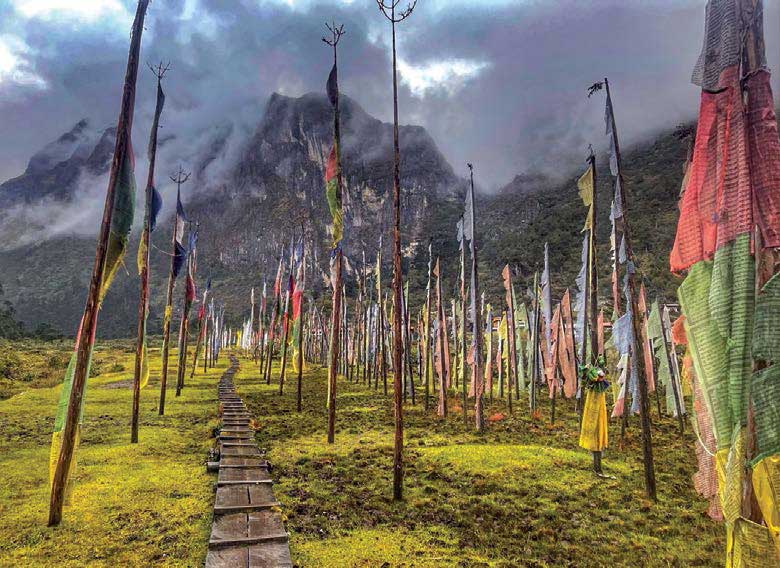The Bumdra Trek is undoubtedly one of Bhutan’s most visually stunning treks with a night of camping in the wild. The trek offers the unique opportunity to experience the pristine natural landscapes combined with some of Bhutan’s most iconic cultural sites.
Bumdra literally means the rock of one hundred thousand foot prints of dakinis (female celestial beings). Legend has it that some 800 years ago, a hundred thousand dakinis flew to this place and left their footprints on the rock. Hence, its spiritual significance!
The trek also gives you an opportunity to visit a sky burial site, if you haven’t seen one yet. The sky burial site is located at the top of the ridge above Bumdra Monastery.


Sky burial is an ancient funeral where human corpse is placed on a mountaintop to decompose, exposing it to the natural elements or offering it to scavenging animals, especially carrion birds. The purpose of sky burial from a cultural and spiritual context is to primarily offer the remains of human body to hungry animals in an ultimate act of generosity – giving even in death. However, the practice has become obsolete today, rarely practiced in some remote highland communities in Bhutan.
At Bumdra, there are three different sky burial sites, and usually the first one, located at an altitude of roughly 4300m, is visited the most. The second and the third sites are further up from the first, and without proper trails, reaching these sky burial sites can be difficult.
The camp site is located at an altitude of around 3850m. Given the altitude and moderate level of difficulty, the trek requires a certain degree of fitness, as some parts of the route can be a tad arduous.

While on this trek, besides the scenic beauty of Himalayan mountain ranges, you can also visit two of the most revered Buddhist pilgrimage sites in Bhutan – Bumdra and Taktshang Monastery (Tiger’s Nest).
Camping options are many, from basic sleep-in tent to luxury glamping services now available at Bumdra.
There also a few route options for the trek to Bumdra. You can start the trek from Shari Village, or through Taktshang or from Sangchoekor Monastery. The recommended route however is from Sangchoekor Monastery, a Buddhist college, home to some 150 monks, perched high above Paro valley.
On a clear day, the panaroamic view of Paro valley from the Monastery is simply breathtaking. A paved road leads to the Monastery. The trek starts from the car parking at the Monastery, leading up the ridges with pristine forest. The hike continues till a clearing with prayer flags, offering breathtaking view of Paro and Dochhu valleys.
The initial 1–2 hour ascent of the ridge can be steep but most part of the route goes through a vegetation of trees, providing cool shade. Afer 2-3 hours of hike you will reach Chhoe Tse Lhakhang (temple), which is built on the side of the mountain. A short break is recommend here!
Some hikers also have lunch at this place but only if you are planning a night at the camp. Good hikers do a round trip in a day. But that would mean you need to start really early and it can be quite exhausting if your are not physically prepared.
The trail continues further up the ridge from the temple. It takes roughly around 20 minutes to reach a flat area, from which point the trail gradually ascends until you reach the camp site. But it does not get much steeper. It takes about another 40 minutes to reach the camp site.
The trail from here till the camp site takes you through a wide meadow with sacred chortens and prayer flags. And finally you will find yourself hiking in an open area, greeted by the Bumdra Lhakhang nestled in a cave just behind the camp site.
On reaching the camp site, you have the option to visit the temple or just relax and enjoy the scenery. If you are interested in meditation, you can’t find a better place than this to do so.
Glamping services at Bumdra offer luxury camping with delicious food. Bookings will have to be made at least a week before the trip if you are planning to spend a night at the camp.
Next morning, from the camp site, you can either head straight back to the valley or hike towards the ridge, soaking up the view and perhaps hang some prayer flags for good luck. The trail drops into a pine and rhododendron forest and zigzags downward to the Tiger’s Nest.



After 1-2 hours of descent, you catch a glimpse of the golden roofs of Buddhist temples perched on high ridges. You will come across two temples before reaching the Zangdopelri Monastery (Copper Paradise of Guru Rinpoche). The temples here are mostly for the purpose of meditation. From the Zangdopelri, you can bravely peer over the edge, straight down onto the ornate roofs of Taktsang Monastery, precariously hanging by the cliff far below. Another hour of hike will take you to the iconic Tiger’s Nest temple. From the temple it takes around two and half hours to reach the road point.
Along the trail, you can also take a short break at the café to enjoy the beautiful sight of Tiger’s Nest on the rockface – this is a perfect spot to take photographs with the Tiger’s Nest in the background.
The best season for Bumdra Trek is during March-May and September-November.

Passang Tshering
He is a qualified tour guide (culture and trekking). He leads tour groups across Bhutan. He enjoys photography and Facebook and Instagram blogging. You can follow him on Facebook and Instagram @bhutanwithpassang.



